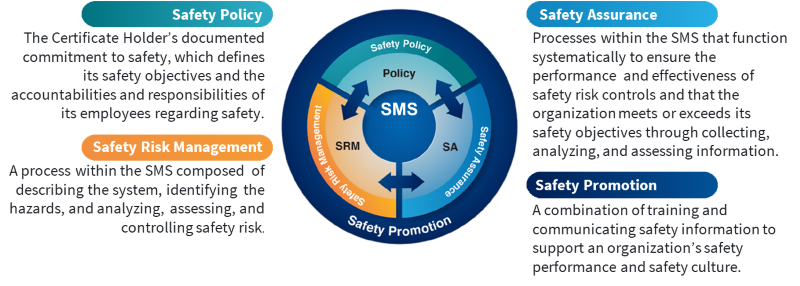
NASHVILLE—NBAA welcomed the extension of the comment period for the FAA's safety management system (SMS) proposed rule, which the association views as the biggest regulatory issue general aviation has faced in more than a decade.
The FAA proposes to update and expand its Part 5 requirement for SMS implementation beyond airlines to include Part 135 charter operators, Part 91.147 air tour operators and aircraft manufacturers. The agency published a notice of proposed rulemaking (NPRM) in the Federal Register on Jan. 11 and previously set a March 13 deadline for comments. The comment period has been extended to April 11.
If adopted as proposed, the rule would affect about 2,600 charter and air tour operators of all sizes, requiring them to implement organization-wide SMS programs to manage safety risk. Companies ranging from fleet operators to single-pilot, single-aircraft operators would have two years after a final rule is published to introduce their programs.
The FAA estimates that about 200 operators participate in its SMS voluntary program, which operators have found difficult to implement, Douglas Carr, NBAA senior vice president of safety, security, sustainability and international operations, said Jan. 25.

“Scalability is a very big component of whether or not the implementation of Part 5 is going to be successful,” Carr said. “We’ve heard a variety of feedback from operators who have attempted to pursue the FAA’s voluntary program and weren’t able to get very far before the workload consumed them and they weren’t able to see the value of the safety components that they were trying to get out of the program. I think there are far more starts than finishes to the program that we’re aware of.”
Carr spoke during a special SMS session at the NBAA Schedulers and Dispatchers Conference that was scheduled after the FAA’s release of the NPRM in early January. In conversation after the session, he compared the pending rule to the biggest regulatory issue the GA industry has faced since the Transportation Security Administration in 2008 proposed, but ultimately withdrew, a requirement that operators implement a Large Aircraft Security Program.
“I believe it’s going to be difficult, if not nearly impossible, for NBAA to oppose this [SMS] rule,” Carr told conference attendees. “We have been strong supporters of SMS for close to 20 years, and now to say SMS mandates are bad—that destroys a lot of credibility. What I think we’re going to be able to do is to help the FAA define what success looks like, and scalability is going to be the key to that.”
Provisions of the proposed Part 5 update that are expected to have the most impact on GA operators, Carr said, include requiring companies to have a code of ethics and a confidential employee reporting system; changed definitions of words such as “hazard,” to more closely align with International Civil Aviation Organization (ICAO) definitions; and requiring operators to maintain descriptions of the products and services provided by their companies as well as by interfacing persons and companies such as FBOs that contribute to the overall safety of products and services.
The NPRM also represents a “fascinating intersection” of two major issues facing Part 135 operators—SMS and Part 135 flight and duty time requirements, “something the industry and the FAA have been struggling to address for about the last 30 years, unsuccessfully at this point,” Carr said. “The FAA has asked us, the industry and the public, to comment on whether we feel flight and duty time can be effectively managed through an SMS,” he advised. “[It’s] an interesting question, one that I think takes us to a program that many folks know of as a fatigue risk management system, which is a safety- and data-driven process for managing fatigue. It’s unclear where we may end up on this.”
IS-BAO Voluntary Standard
W. Ashley Smith Jr., president and operations director of Part 135 air medical provider Jet Logistics, said the company he founded in 2002 adopted the safety-centric International Standard for Business Aircraft Operations (IS-BAO) voluntary standard when it planned to start flying to Bermuda, which required an internationally recognized SMS. The Johns Island, South Carolina-based company operates a fleet of 16 Citation, Lear and Hawker jets for patient and donor organ transport.
During the question period, Smith asked: “Why could [the FAA] not look at IS-BAO as a deemed status? In states that require medical licensure for the business that I’m in, if you’re an accredited body, you don’t have to prove that you meet the requirements of the state because you’ve proven it to an independent third-party auditor. If you’ve done that in the case of IS-BAO, you’ve proven that you have an acceptable SMS. And that’s a little bit more scalable than Part 5.”
Speaking later with BCA, Smith said Jet Logistics started implementing an SMS through the FAA’s voluntary program but abandoned the effort after finding that it was detracting from the IS-BAO process, which involves three progressive stages of maturity.
“What concerns me is that the FAA will do one of two things,” Smith said. “They will either just simply make Part 5 applicable to us, which would make it complicated and overly burdensome, or they would try to mirror something like their voluntary program, which is also complicated and overly burdensome. That’s why I talk about, is there a way we could sell them on IS-BAO because a lot of industry has already embraced it and already started down that path. So, you would have a lot faster implementation. The problem is that the FAA does not like to outsource things.”
Carr said NBAA had sought an extension of 30-60 days to the comment period for the FAA’s SMS proposed rule to gather more information from operators to help craft the new regulation.
“A very significant portion” of the 1,907 Part 135 operators the FAA estimates would be affected by the regulation have one pilot and one airplane, and most of those are small piston-powered aircraft, Carr said. By percentage, the majority of those operators are based in Alaska. The FAA has also questioned in the NPRM if smaller operators should be included; it estimates there are 694 operators flying under Part 91.147.
“When we’re thinking through this, the scale of the operator that I’m trying to understand is the smallest of the small, the one-person, one-aircraft operator who is either doing an air tour or maybe delivering mail up in Alaska,” Carr said. “How is this going to look for them? Not that it can’t [succeed] but what does it look like?”


